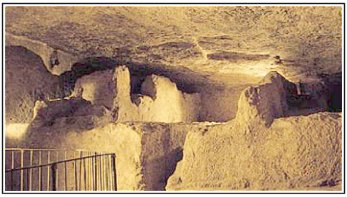|
The
remnants and ruins of ancient Egypt,
particularly Giza, are intriguing, and
have been an enigma for thousands of
years. No records exist describing who
built the Giza pyramids or why. Over
the decades and centuries there have
been many theories proposed as to how
these pyramids were built and why.
Most theories describing the purpose
of the pyramids, however, have been
lacking in the application of science
in the analysis of ancient Egypt’s
past.
One
of the greatest of history’s
mysteries is the Great Pyramid of Giza.
Its structural perfection is matched
only by its mysterious interior
design, and at the bottom of this
great limestone pyramid is a manmade
cavern designed for what purpose?
Of
all the chambers and passageways in
the Great Pyramid, the subterranean
chamber is the largest and most
unusual. Located one hundred feet
below the base of the Great Pyramid,
this odd looking room was carved from
solid limestone bedrock and measures
twenty-seven feet north to south and
fifty-six feet east to west with its
entrance is near the floor at the
northeast corner.
While
the eastern half of the room averages
only 11 to 13 feet in height, the
western half is five and a half feet
high stepped with a tapered channel
leading to the western wall. On top of
the step two fins run from the front
of the step to the back wall. A third
fin was carved half way back on the
step.

Chamber 'Fins'
All
of the fins run east to west and reach
up near the ceiling. On the main floor
there is a six-foot wide square pit
approximately five feet from the
eastern wall and drops five and a half
feet further into the bedrock where it
narrows to four feet square. Although
the depth of the pit is eleven feet,
during the 1800’s Cavigula drilled
down another thirty feet.
In
the subterranean chamber’s
southeastern corner there is an
entrance to a tunnel measuring 29
inches by 31 inches, often referred to
as the ”dead end” shaft, which
runs fifty-seven feet due south where
it ends at a vertical wall.
The
Great Pyramid’s strange subterranean
chamber is thought to have been an
unfinished chamber. But after years of
experimentation and model building it
is now clear that the strange
configuration of the Great Pyramid’s
subterranean chamber is not an
unfinished chamber. I have proven that
the design of the subterranean chamber
and its associated passageways is
deliberate and are functionally
equivalent to a pulse pump, commonly
known as a ‘ram pump.’ The
evidence is physical and any scientist
or engineer may duplicate my work.
| 